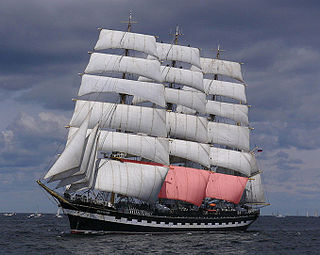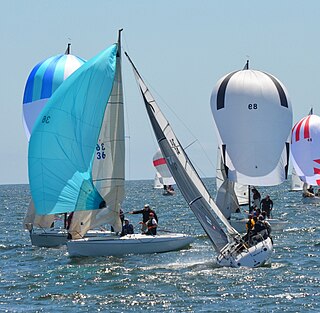
Sailing employs the wind—acting on sails, wingsails or kites—to propel a craft on the surface of the water, on ice (iceboat) or on land over a chosen course, which is often part of a larger plan of navigation.

A jibe (US) or gybe (Britain) is a sailing maneuver whereby a sailing vessel reaching downwind turns its stern through the wind, such that the wind direction changes from one side of the boat to the other. For square-rigged ships, this maneuver is called wearing ship.

A spinnaker is a sail designed specifically for sailing off the wind from a reaching course to a downwind, i.e. with the wind 90–180° off bow. The spinnaker fills with wind and balloons out in front of the boat when it is deployed, called flying. It is constructed of lightweight fabric, usually nylon, and is often brightly coloured. It may be optimised for a particular range of wind angles, as either a reaching or a running spinnaker, by the shaping of the panels and seams.

A mainsail is a sail rigged on the main mast of a sailing vessel.

Running rigging is the rigging of a sailing vessel that is used for raising, lowering, shaping and controlling the sails on a sailing vessel—as opposed to the standing rigging, which supports the mast and bowsprit. Running rigging varies between vessels that are rigged fore and aft and those that are square-rigged.

Sail components include the features that define a sail's shape and function, plus its constituent parts from which it is manufactured. A sail may be classified in a variety of ways, including by its orientation to the vessel and its shape,. Sails are typically constructed out of flexible material that is shaped by various means, while in use, to offer an appropriate airfoil, according to the strength and apparent direction of the wind. A variety of features and fittings allow the sail to be attached to lines and spars.
A guy-wire, guy-line, or guy-rope, also known as simply a guy, is a tensioned cable designed to add stability to a free-standing structure. They are used commonly for ship masts, radio masts, wind turbines, utility poles, and tents. A thin vertical mast supported by guy wires is called a guyed mast. Structures that support antennas are frequently of a lattice construction and are called "towers". One end of the guy is attached to the structure, and the other is anchored to the ground at some distance from the mast or tower base. The tension in the diagonal guy-wire, combined with the compression and buckling strength of the structure, allows the structure to withstand lateral loads such as wind or the weight of cantilevered structures. They are installed radially, usually at equal angles about the structure, in trios and quads. As the tower leans a bit due to the wind force, the increased guy tension is resolved into a compression force in the tower or mast and a lateral force that resists the wind load. For example, antenna masts are often held up by three guy-wires at 120° angles. Structures with predictable lateral loads, such as electrical utility poles, may require only a single guy-wire to offset the lateral pull of the electrical wires, at a spot where the wires change direction.

In sailing, a boom is a spar (pole), along the of a fore and aft rigged sail, that greatly improves control of the angle and shape of the sail. The primary action of the boom is to keep the foot flatter when the sail angle is away from the centerline of the boat. The boom also serves as an attachment point for more sophisticated control lines. Because of the improved sail control it is rare to find a non-headsail without a boom, but lateen sails, for instance, are loose-footed. In some modern applications, the sail is rolled up into the boom for storage or reefing.

A guy is a line (rope) attached to and intended to control the end of a spar on a sailboat. On a modern sloop-rigged sailboat with a symmetric spinnaker, the spinnaker pole is the spar most commonly controlled by one or more guys.

A boom vang (US) or kicking strap (UK) is a line or piston system on a sailboat used to exert downward force on the boom and thus control the shape of the sail. The Collins English Dictionary defines it as "A rope or tackle extended from the boom of a fore-and-aft mainsail to a deck fitting of a vessel when running, in order to keep the boom from riding up".

A spinnaker pole is a spar used in sailboats to help support and control a variety of headsails, particularly the spinnaker. However, it is also used with other sails, such as genoas and jibs, when sailing downwind with no spinnaker hoisted.

A fractional rig on a sailing vessel consists of a foresail, such as a jib or genoa sail, that does not reach all the way to the top of the mast.

The junk rig, also known as the Chinese lugsail or sampan rig, is a type of sail rig in which rigid members, called battens, span the full width of the sail and extend the sail forward of the mast.
The Hobie 33 is an American trailerable sailboat that was designed by Hobie Alter and Phil Edwards as one-design racer and first built in 1982. It was the first monohull design for Alter and his company, after establishing their reputations for their lines of surfboards and catamarans

A trailer sailer is a type of sailboat that has been designed to be easily transported using a road trailer towed by an automobile. They are generally larger than a sailing dinghy. Trailer sailers include day sailers and small cabin cruisers, suitable for living on.

Forces on sails result from movement of air that interacts with sails and gives them motive power for sailing craft, including sailing ships, sailboats, windsurfers, ice boats, and sail-powered land vehicles. Similar principles in a rotating frame of reference apply to wind mill sails and wind turbine blades, which are also wind-driven. They are differentiated from forces on wings, and propeller blades, the actions of which are not adjusted to the wind. Kites also power certain sailing craft, but do not employ a mast to support the airfoil and are beyond the scope of this article.

Ljungström rig is the name for the sailing rig designed by Swedish engineer Fredrik Ljungström with double main sails and rotating mast, but without boom, foresail, forestay and shroud. The early models of the Ljungström sailboat had a stern stay but this was omitted around 1945, before the model 12.

A sail is a tensile structure—made from fabric or other membrane materials—that uses wind power to propel sailing craft, including sailing ships, sailboats, windsurfers, ice boats, and even sail-powered land vehicles. Sails may be made from a combination of woven materials—including canvas or polyester cloth, laminated membranes or bonded filaments—usually in a three- or four-sided shape.
The following outline is provided as an overview of and topical guide to sailing:

The lug sail, or lugsail, is a fore-and-aft, four-cornered sail that is suspended from a spar, called a yard. When raised, the sail area overlaps the mast. For "standing lug" rigs, the sail may remain on the same side of the mast on both the port and starboard tacks. For "dipping lug" rigs, the sail is lowered partially or totally to be brought around to the leeward side of the mast in order to optimize the efficiency of the sail on both tacks.


















